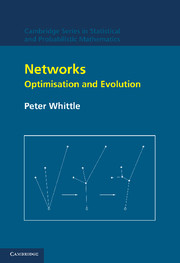Book contents
- Frontmatter
- Contents
- Acknowledgements
- Conventions on notation
- Tour d'Horizon
- Part I Distributional networks
- Part II Artificial neural networks
- Part III Processing networks
- Part IV Communication networks
- 15 Loss networks: optimisation and robustness
- 16 Loss networks: stochastics and self-regulation
- 17 Operation of the Internet
- 18 Evolving networks and the Worldwide Web
- Appendix 1 Spatial integrals for the telephone problem
- Appendix 2 Bandit and tax processes
- Appendix 3 Random graphs and polymer models
- References
- Index
16 - Loss networks: stochastics and self-regulation
Published online by Cambridge University Press: 23 November 2009
- Frontmatter
- Contents
- Acknowledgements
- Conventions on notation
- Tour d'Horizon
- Part I Distributional networks
- Part II Artificial neural networks
- Part III Processing networks
- Part IV Communication networks
- 15 Loss networks: optimisation and robustness
- 16 Loss networks: stochastics and self-regulation
- 17 Operation of the Internet
- 18 Evolving networks and the Worldwide Web
- Appendix 1 Spatial integrals for the telephone problem
- Appendix 2 Bandit and tax processes
- Appendix 3 Random graphs and polymer models
- References
- Index
Summary
The treatment of the last chapter ignored the statistical variation in input under a fixed demand pattern. However, one should check that this does not lead one to miss points of real significance, affecting both performance and operation. As far as operation goes, we simply assumed in Chapter 15 that the optimal quotas determined for admission and routing could be achieved somehow. ‘How?’ can only be settled by consideration of a model that is both dynamic and stochastic. A stochastic formulation forces one to develop control rules in terms of current state, which alone can extract best advantage from fortuitous variation while observing constraints.
The adaptability to stochastic state thus achieved can also provide a substantial degree of adaptability to changes in demand. However, as far as the optimisation of design is concerned, the effect of stochastic variation of state for fixed demand will be secondary in comparison with that of the major variations in demand considered in Section 15.3.
A single exchange; Erlang's formula
Before considering the stochastic version of the full net, it is useful to consider the case of a single exchange. Suppose that an exchange offers a single link to some other destination, consisting of G parallel circuits, any one of which can carry a call. Calls arrive in a Poisson stream of rate λ, and will be accepted if there is a circuit free. Once connected, the call will terminate with a probability intensity μ, independently of the state of the exchange. This state is then described by n, the number of busy circuits.
- Type
- Chapter
- Information
- NetworksOptimisation and Evolution, pp. 199 - 210Publisher: Cambridge University PressPrint publication year: 2007

